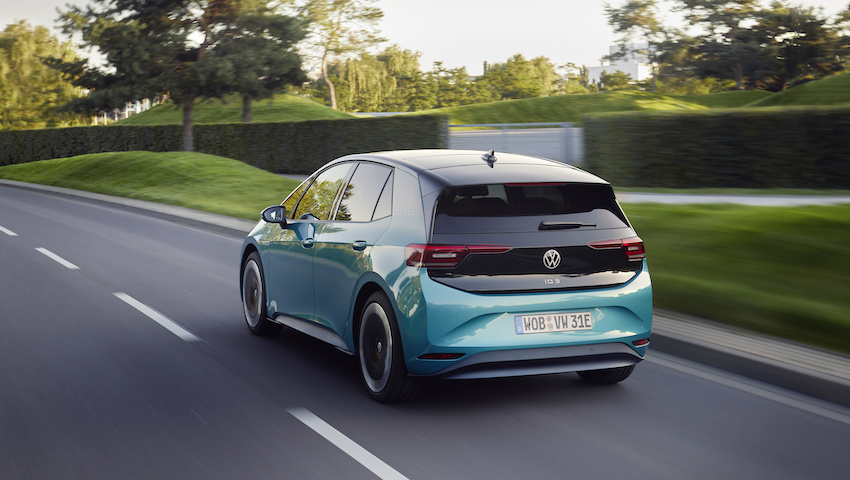VWFS publishes second electric vehicle tracking report
Volkswagen Financial Services UK (VWFS) has published its first quarterly electric vehicle Tracker Report in spring 2022.
Its aim was to evaluate the progress being made as the nation moves towards mainstream adoption of electric vehicles and greener transport solutions that will help achieve the UK Government’s net zero target.
The first report set out statistical evidence that tracks EV uptake against the required adoption curve, as well as highlighting challenges and concerns around the current public charging infrastructure and the key factors influencing consumer and business sentiment when it comes to switching to electric.
This second tracker report continues to shed light on these critical areas. Using a combination of the latest available data from reputable sources and exclusively commissioned consumer research, it looks at how EV adoption is progressing, how consumers and organisations are feeling and acting and the primary factors that may influence future decision-making.
The EV adoption curve
The positive momentum seen in the first EV tracker report, as consumers and businesses make the switch to more environmentally friendly transport solutions, continues in this second quarterly report.
According to the latest statistics from the Department for Transport (DfT), more battery electric (BEV) cars (64,000) were registered for the first time in the UK during Q1 2022 (January to March) than diesel cars (34,000), following a 102% annual increase in BEV cars compared to Q1 2021.
By contrast, over the same period, there were falls of 11% and 52% for petrol and diesel cars respectively, whilst average CO2 emissions for cars registered for the first time in the UK decreased by 13% in Q1 2022 versus Q1 2021.
Even more up-to-date figures from the SMMT show that BEVs continued their growth streak in June, with a 14.6% increase in volume, as market share continued to grow, reaching 16.1%, up from 10.7% a year before. Over the same period, diesel and petrol vehicles fell 46.7% and 28.2% respectively.
The Climate Change Committee has set out an EV adoption curve until 2032. Data compiled by Volkswagen Financial Services UK shows that the UK is 101,840 EVs ahead of the curve.
At the end of March 2022, there were 833,000 licensed ultra-low emission vehicles in the UK – the equivalent of 1 in 50 of all vehicles on UK roads. To put this market dynamic acceleration into context, this was an increase of 71% compared to the end of March 2021.
These numbers depict a steeper-than-needed adoption rate, which is to be welcomed if the Climate Change Committee’s ultimate target of 55% of all light duty vehicles being battery powered by 2032 is to be met.
The public charging infrastructure challenge
Whilst EV sales continue to experience excellent levels of growth, it contrasts with ongoing concerns about the public charging infrastructure needed to support the mass move to sustainable transport.
Increasingly, would-be EV purchasers are expressing reluctance to switch until they have confidence that an adequate charging infrastructure is in place in the UK. Currently, only 24% of consumers are confident that sufficient charging infrastructure is in place to support wider adoption of electric vehicles.
The Competition and Markets Authority suggests that the nation will need 480,000 public charging points by 2030. But current progress remains slow.
In the year to July 2022, just 7,637 additional charging points were installed, bringing the overall total across the UK to 32,011. The European Commission recommends a ratio of one charger per every 10 EVs.
However, we know from OZEV EV Grant data that approximately 300,000 home chargepoints have been installed across the UK and a further circa 200,000 workplace chargers have been fitted as part of the Workplace Charging Scheme.
Therefore, the conundrum of a lack of public charge points is a common misconception. The bigger issue is ensuring that the nation’s public charging network becomes more accessible.
For example, that public chargepoints are easily compatible with a uniform contactless payment method, are reliable and deliver the advertised power (particularly relevant for ultra-rapid chargers); a potential solution could see providers bound by industry standard SLAs regulated by Ofgem.
Clearly, charge points must also be evenly spread in sufficient numbers across the UK.
Where public charging installation has occurred, a postcode lottery remains in place. Based on public charging points per 100,000 people London (116), Scotland (55), the South East (44) and the South West (39) continue to see the highest level of charging points, whilst Yorkshire and the Humber (29), the North West (27) and Northern Ireland (17) show the lowest level.
However, the positive news is that between April and June 2022, all regions across the UK, apart from Northern Ireland, saw an increase in total charging devices. The North East had the greatest increase at 14.2%, whilst London had the greatest increase in absolute number of devices at 462 devices, contributing to 27% of the increase in devices across the UK in this period.
Interestingly, Scotland has the highest rate of rapid device provision of 14.2 rapid devices per 100,000, with the average provision in the UK being 8.9 per 100,000.
It is no coincidence that adoption of EVs is happening more quickly across the South of England, where charging infrastructure enhancements are taking place at a far swifter rate than other areas of the UK.
Such inequality needs to be addressed without delay to ensure that the EV adoption rate is both maintained and distributed more equally across the whole of the nation.
Consumer sentiment and influences
As alluded to in the first EV tracker report, predicted economic headwinds have become a reality and, with it, a clear influence on consumer-driven larger discretionary purchases, including electric vehicles.
New consumer research conducted in June 2022 which has tracked consumer confidence since 2018, shows that net confidence in the UK economy and net confidence in household finances are at their lowest levels for four years.
As costs soar, driven by significant energy, fuel and food price hikes, the cost-of-living crisis is affecting all households and some consumers are now being forced to dip into savings to fund their daily lives. This is limiting disposable incomes and driving caution when buying bigger ticket items.
38% of consumers say they plan to delay the purchase of a new car because of the current economic outlook, whilst over a third say they have cut back on the amount of driving they undertake due to the cost of fuel at the pump.
However, for those considering the purchase of an EV, issues such as better access to quality charging points (37%), the high price of petrol (36%) and longer ranges on a single charge (35%), are viewed as the most important factors swaying their thinking.
In the short term, consumers and businesses will be looking to tighten belts and ride out the economic storm in the hope the heightened inflation rate and price hikes will begin to subside in due course.
It will be interesting to monitor the effect a financial squeeze will have on the positive momentum previously seen in the number of EV sales, and whether the excellent adoption curve status can be maintained during and after a period of fiscal pressure and turbulence.
Educating the potential EV market
The EV marketplace remains beset by consumer preconceptions, misunderstandings, and overall lack of detailed knowledge.
These include key issues such as existing model options, EV pricing, environmental perceptions, and information complexity. By proactively addressing these salient consumer-held opinions through communication and education initiatives, the automotive sector may be in a stronger position to persuade reluctant EVs considerers in the future.
Key findings in recent consumer research found that:
56% of consumers think that electric cars are better for the environment
Just 24% of consumers are ‘confident’ that there is charging infrastructure in place to support electric vehicles
58% of consumers currently think that the cost of a product is ‘more important’ than how sustainable it is
The cost of petrol and diesel has prompted 31% of consumers to seriously consider an electric car for the first time
When it comes to considering the purchase of an EV, 74% of consumers believe that electric and hybrid cars remain too expensive and only 32% think there is plenty of EV choice.
This last point contrasts with figures from the Society of Motor Manufacturers & Traders (SMMT). They state that there is currently more than 140 diverse types of plug-in vehicles to choose from, with more on the cusp of being launched by a number of large manufacturers. There has been a 15-fold increase in the choice of electric vehicles since 2011, but this evolution still does not resonate with a proportion of consumers.
eLCV status
Reflecting the positive progress of EV car adoption, figures for eLCV (vans) also shows tangible promise. As of March 2022, the UK eLCV fleet size stood at 32,000, accounting for 4% of the UK’s licensed plug-in vehicles.
It’s predicted that this growth momentum will continue through 2022 as more vans are launched, with new options from both Volkswagen and Ford, among others. This delivers increased choice to businesses looking for greener transport options. It also removes the time and resources needed to retrofit and alter existing petrol and diesel powered LCVs which has been the preferred route for many business owners until now, and who have been put off by eLCV choice, availability, and cost.
Conclusion
Mike Todd, CEO at Volkswagen Financial Services UK, said: “Our second EV tracker highlights how the market continues to evolve and the influences that impact decision making.
“It’s encouraging to see that EV adoption remains strong and that the UK is currently tracking ahead of the required Climate Change Committee adoption curve by over 100,000 vehicles. However, future progress must be closely monitored to assess the short- and long-term impact of two primary areas of concern.
“First is the general worry about the robustness of the public charging infrastructure and the speed at which charging points are being installed equally around the country. This must keep pace with growing demands or risk stalling EV take-up momentum.
“The regional variances in charging infrastructure installation must also be addressed to underpin more equitable nationwide EV adoption. The latest Department for Transport charging point figures clearly illustrate that more needs to be done in this critical area.
“The second issue is associated with the current cost of living crisis and how it will influence potential purchasers, certainly in the short term. Although 31% of consumers are now ‘seriously considering’ buying an electric vehicle for the first time due to the rapid rise in petrol and diesel prices, nonetheless as household budgets come under pressure, other priorities may prevail which could potentially affect EV sale impetus and limit the surge in EV adoption witnessed over the past few years.
“Our role as a finance provider is to help consumers with these affordability issues, which is why we continue to develop propositions to assist customers make the transition to electric cars.”






